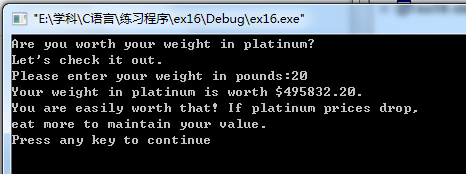一、初识C语言
1.1 C语言的起源
1972年,贝尔实验室的丹尼斯,里奇和肯,汤普逊在开发UNIX操作系统时设计了C语言,然而,C语言不完全是里奇突发奇想出来的,他是在B语言的基础上进行设计的,至于B语言的起源是另外一个故事,C语言设计的初衷是将其作为程序员使用的的一种编程工具,因此,其主要主要目标是成为有用的语言。
1.2 C语言的优缺点
优点:
1.设计特性:C语言程序编写更易懂、更可靠。
2.高效性:C程序更加紧凑,而且运行速度快
3.可移植性:在一种系统C程序稍作修改,或不做修改就可以在其他系统运行。
4.强大的灵活性:许多的编译器和解释器都是用C语言编写的(FORTRAN、Perl、python、BASIAC...)。
5.面向程序员:C语言是为了满足程序员的需求而设计的,程序员可以通过C访问硬 件,操控内存中的位
缺点:C语言使用指针,而涉及指针的编程错误往往难以察觉。
二、C语言概述
2.1 简单的C程序示例
1 #include <stdio.h> 2 3 void main() 4 { 5 int num; 6 num = 1; 7 8 printf("I an a simple"); 9 printf(" coputer.\n"); 10 printf("My favorite number is %d because it is the first number\n"); 11 }
运行结果如下:

注:如何进行注释?
单行注释://
多行注释:/* 注释内容 */
2.2 变量命名
可以用小写字母,大写字母,数字和下划线(_)来命名,而且,名称的第一个字符必须是字母或者下划线不能是数字
2.3 进一步使用C
1 #include <stdio.h> 2 3 void main() 4 { 5 int feet, fathoms; 6 7 fathoms = 2; 8 feet = 6 * fathoms; 9 printf("There are %d feet in %d fathoms!\n", feet, fathoms); 10 printf("Yes, I said %d feet!\n", feet); 11 }
运行结果如下:

三、数据和C
3.1 程序示例
1 #include <stdio.h> 2 3 void main() 4 { 5 float weight; 6 float value; 7 8 printf("Are you worth your weight in platinum?\n"); 9 printf("Let's check it out.\n"); 10 printf("Please enter your weight in pounds:"); 11 scanf("%f",&weight); 12 value = 1700.0 * weight * 14.5833; 13 printf("Your weight in platinum is worth $%.2f.\n",value); 14 printf("You are easily worth that! If platinum prices drop,\n"); 15 printf("eat more to maintain your value.\n"); 16 }
运行结果:
